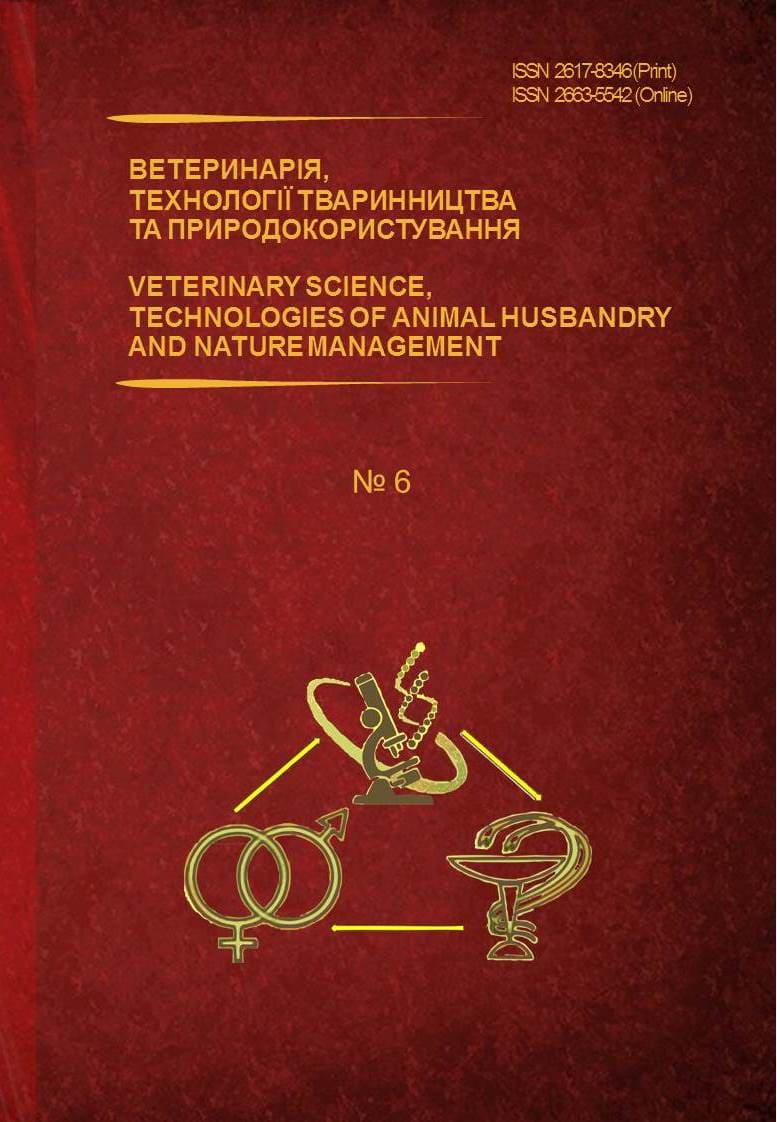Валідація методики кількісного визначення флорфеніколу у зразках м’язів методом імуноферментного аналізу
Анотація
Амфеніколи – група хімічних сполук з антибактеріальною активністю, до складу входять хлорамфенікол (ХАФ), тіамфенікол (ТАФ), флорфенікол (ФФ) та їх похідники. Встановлені валідаційні характеристики щодо визначення залишків флорфеніколу у зразках м’язів, такі як: здатність виявлення (ССβ) становить 5,0 мкг/кг, рівень відсічення – 3,62 мкг/кг. Найменший вміст флорфеніколу, що може бути визначеним – 0,2 мкг/кг.
Завантаження
Посилання
Aarestrup, F. (2012). Sustainable farming: Get pigs off antibiotics. Nature, 486, 465–466. DOI: 10.1038/486465a.
Anadón, A., Martínez, M. A., Martínez, M., Ríos, A., Caballero, V., Ares, I., & Martínez-Larrañaga, M. R. (2008). Plasma and tissue depletion of florfenicol and florfenicol-amine in chickens. J Agric Food Chem., 56 (22), 11049-11056. DOI: 10.1021/jf802138y.
Chang, S. K., Davis, J. L., Cheng, C. N., Shien, R. H., Hsieh, M. K., Koh, B. W., & Chou, C. C. (2009). Pharmacokinetics and tissue depletion of florfenicol in Leghorn and Taiwan Native chickens. J. vet. Pharmacol. Therap., 33, 471–479. DOI: 10.1111/j.1365-2885.2009.01155.x.
Commission Regulation (EU) No 37/2010 of 22 December 2009 on pharmacologically active substances and their classification regarding maximum residue limits in foodstuffs of animal origin (Text with EEA relevance). OJ, L 15, 20.1.2010, 1–72. Retrieved from: https://eur-lex.europa.eu/legal-content/EN/TXT/?uri=celex%3A32010R0037.
Cooper, K. M., Mccracken, R. J., Buurman, M., & Kennedy, D. G. (2008). Residues of nitrofuran antibiotic parent compounds and metabolites in eyes of broiler chickens. Food Additives & Contaminants: Part A, 25(5), 548–556. DOI: 10.1080/02652030701586657.
Council Directive 96/23/EC of 29 April 1996 on measures to monitor certain substances and residues thereof in live animals and animal products and repealing Directives 85/358/EEC and 86/469/EEC and Decisions 89/187/EEC and 91/664/EEC. OJ, L 125, 23.5.1996, 10. Retrieved from: http://data.europa.eu/eli/dir/1996/23/2013-07-01.
Council Regulation (EEC) No 2377/90 of 26 June 1990 laying down a Community procedure for the establishment of maximum residue limits of veterinary medicinal products in foodstuffs of animal origin. OJ, L 224, 18.8.1990, 1–8. Retrieved from: http://data.europa.eu/eli/reg/1990/2377/oj.
DNDILDVSE. (2018). Quantitative determination of florfenicol and thiamphenicol using a test system for enzyme-linked immunosorbent assay Kwinbon Biotech Florfenicol and Thiamphenicol (Cat.No.: KA12901H) method. recommendations. [in Ukrainian]
Fahim, A., Aslam, B., Mohsin, M., Raza, A., Faisal, M. N., & Hussain, A. (2018). Estimation of florfenicol residues in layer meat and egg samples using high performance liquid chromatography. Pak Vet J, 38(3), 329-332. DOI: 10.29261/pakvetj/2018.052.
Falowo, A., & Akinmoladun, O. (2019). Veterinary Drug Residues in Meat and Meat Products: Occurrence, Detection and Implications. Veterinary Pharmaceuticals. DOI: 10.5772/intechopen.83616.
FAO. (2017). Antimicrobial resistance (AMR): the loss of a major defence to the emerging challenge. European Commission on Agriculture (ECA) 40th Session. Budapest, Hungary. 27-28 September 2017. Retrieved from: http://www.fao.org/3/a-mu349e.pdf.
Fodey, T. L., George, S.E., Traynor, I. M., Delahaut, P., Kennedy, D. G., Elliott, C. T., & Crooks, S. R. (2013). Approaches for the simultaneous detection of thiamphenicol, florfenicol and florfenicol amine using immunochemical techniques. J Immunol Methods, 3393(1-2), 30-37. DOI: 10.1016/j.jim.2013.04.003.
Ivanova, O., & Galkin, A. (2018). Comparative Characteristics of Physical, Chemical, and Biochemical Methods for Determining Nitrofuran Metabolites in Food. Innovative Biosystems and Bioengi-neering, 2 (1), 49–56. DOI: 10.20535/ibb.2018.2.1.127257.
Mistiri, F., Louati, K., Grissa, O., Kallel, M., & Safta, F. (2012). Study of forced degradation behaviour of florfenicol by LC and LC-MS and development of a validated stability-indicating assay method. Annales Pharmaceutiques Françaises, 70(6), 333-347. DOI: 10.1016/j.pharma.2012.08.004.
Pietro, W., Woźniak, A., Pasik, K., Cybulski, W., & Krasucka, D. (2014). Amphenicols stability in medicated feed – development and validation of liquid chromatography method. Bulletin of the Veterinary Institute in Pulawy, 58(4), 621-629. DOI: 10.2478/bvip-2014-0095.
Pokrant, E., Riquelme, R., Maddaleno, A., San Martín, B., & Cornejo, J. (2018). Residue Depletion of Florfenicol and Florfenicol Amine in Broiler Chicken Claws and a Comparison of Their Concentrations in Edible Tissues Using LC–MS/MS. Molecules , 23(9), 2211. DOI: 10.3390/molecules23092211.
Van, T. T. H., Yidana, Z., Smooker, P. M., & Coloe, P. J. (2020). Antibiotic use in food animals worldwide, with a focus on Africa: Pluses and minuses. Journal of Global Antimicrobial Resistance, 20, 170–177. DOI: https://doi.org/10.1016/j.jgar.2019.07.031.
Volk, T., Rednak, M., & Erjavec, E. (2017). Agricultural policy developments in Western Balkan countries — regional synthesis. Monitoring of agricultural policy developments in the Western Balkan countries, 2-36. DOI: 10.2760/73968.
Yanovych, D.V., Zasadna, Z. S., Pazderskaya, O. M., & Kislova, S. M. (2014). Application of enzyme-linked immunosorbent assay for screening residual amounts of veterinary drugs and contaminants in products of animal origin. Scientific and Technical Bulletin of the Institute of Animal Biology and the State Research Control Institute of Veterinary Drugs and Feed Additives, 15 (1), 249-255. Retrieved from: http://nbuv.gov.ua/UJRN/Ntbibt_2014_15_1_51. [in Ukrainian]
Zhang, S., Liu, Z., Guo, X. Cheng, L., Wang, Z., & Shen, J. (2008). Simultaneous determination and confirmation of chloramphenicol, thiamphenicol, florfenicol and florfenicol amine in chicken muscle by liquid chromatography-tandem mass spectrometry. Journal of Chromatography B, 875(2), 399-404. DOI: 10.1016/j.jchromb.2008.09.035.
Переглядів анотації: 1340 Завантажень PDF: 616





